
Spawn is a superhero/antihero appearing in a monthly comic book of the same name published by American company Image Comics, as well as in a number of films, television series, and video game adaptations set in the Image Universe. Created by Todd McFarlane, Spawn first appeared in Spawn #1.

Todd McFarlane is a Canadian comic book creator, artist, writer, filmmaker and entrepreneur, best known for his work as the artist on The Amazing Spider-Man and as the creator, writer, and artist on the superhero horror-fantasy series Spawn.

Super Mario World 2: Yoshi's Island is a 1995 platform game developed and published by Nintendo for the Super Nintendo Entertainment System (SNES). The player controls Yoshi, a friendly dinosaur, on a quest to reunite baby Mario with his brother Luigi, who has been kidnapped by Kamek. As a Super Mario series platformer, Yoshi runs and jumps to reach the end of the level while solving puzzles and collecting items with Mario's help. The game has a hand-drawn aesthetic and was the first in the franchise to have Yoshi as its main character, where it introduces his signature flutter jump and egg spawning abilities.

Red Alarm is a 1995 shoot 'em up video game developed by T&E Soft and published by Nintendo. Released as a Virtual Boy launch game, it requires the player to pilot a space fighter and defeat the army of a malevolent artificial intelligence called "KAOS". The game takes inspiration from the 1993 title Star Fox, and it is one of the few third-party titles for the Virtual Boy. Unlike most of the console's games, Red Alarm features three-dimensional (3D) polygonal graphics. However, hardware constraints limited the visuals to bare wire-frame models, similar to those of the 1980 arcade game Battlezone. Reviewers characterized Red Alarm's graphics as confusing, but certain publications praised it as one of the most enjoyable Virtual Boy titles.

Spawn is a 1997 American superhero film based on the Image Comics character of the same name. Directed by Mark A.Z. Dippé, the film stars Michael Jai White in the title role, alongside John Leguizamo, Martin Sheen, Theresa Randle, D. B. Sweeney, and Nicol Williamson in his final film role. The film depicts the origin story of the title character, a murdered US Marine who is resurrected as the reluctant leader of Hell's army. Spawn is one of the first films to feature an African American actor portraying a major comic book superhero.
Hellspawn are fictional supernatural warriors from Todd McFarlane's comic book series, Spawn. The main character in the series, Spawn, is himself a Hellspawn.

Punky Skunk is a side-scrolling action-platform video game developed by Ukiyotei and published by Visit in Japan on 1 November 1996 and by Jaleco in North America in February 1998 for the PlayStation. It takes place on a set of island archipiélagos where the wolf Badler and his legion of mouse-like Chews are threatening to pollute the locations through industries and machinery. Players assume the role of the titular skunk in an attempt to overthrow Badler and his BB Brigade army with the help of his companions Nash and Kelly. Its gameplay mainly consists of platforming using a main three-button configuration.

Violator is a supervillain who appears in the Spawn comic books published by Image Comics. The character first appeared in Spawn #2 and was created by writer-artist Todd McFarlane. He is by far the most recurring villain of the series and Spawn's archenemy. He is also the maker of the Hellspawns, hence, he trains and keeps tabs on them.

Cogliostro is a fictional character in Todd McFarlane's Spawn comic series, set in the Image Universe. Cogliostro was created in 1993 by author Neil Gaiman and artist Todd McFarlane and introduced in Spawn issue #9. Originally depicted as a supporting character, he becomes an antagonist as the series progresses, eventually becoming the supervillain Sinn the third main antagonist of the Spawn universe.
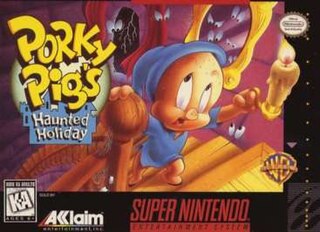
Porky Pig's Haunted Holiday is a 1995 side-scrolling platform video game developed by Phoenix Interactive Entertainment and published by Sunsoft for the Super Nintendo Entertainment System video game console. The goal of the game is to guide the main character, Porky Pig from the Warner Bros. cartoons, through his nightmares. The game received mixed to positive reviews by critics; its graphics and animations were received well while its length and easy difficulty were not.
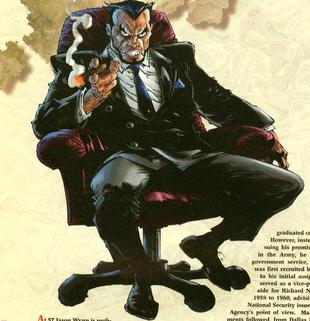
Jason Wynn is a supervillain in the Todd McFarlane Image Universe comic book series Spawn. Wynn is the director of the United States Security Group. He is perhaps the most powerful man in the world, and has politicians throughout the government on his payroll. His actions caused Al Simmons' soul to be sent to Hell and transformed into Spawn in the first place, making him a major villain in the comics as a result.
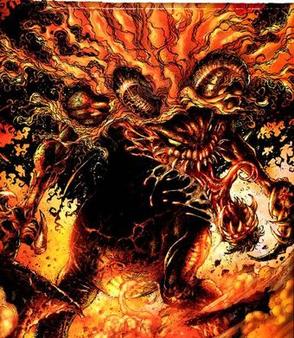
Malebolgia is a supervillain appearing as the original main antagonist in comic books featuring the superhero Spawn and reprised the role in the later issues. Created by writer/artist Todd McFarlane, the character first appeared in Spawn #1. The name Malebolgia is derived from the term in Dante's Inferno used to describe Malebolge, the ditches (bolge) in the eighth circle of Hell, where humans who committed the sin Fraud are punished. He is Spawn's former master who serves as one of the major Lords of Hell.

Todd McFarlane's Spawn, also known as Spawn: The Animated Series or simply Spawn is an American adult animated superhero television series that aired on HBO from 1997 through 1999 and reran on Cartoon Network's Toonami programming block in Japan. It has also been released on DVD as a film series. The show is based on the Spawn character from Image Comics, and won an Emmy Award in 1999 for Outstanding Animation Program.

Troy Aikman NFL Football is an american football video game originally developed by Leland Interactive Media and published by Tradewest for the Super Nintendo Entertainment System first in North America on August 1994. Officially licensed from the National Football League, it prominently features former NFL player Troy Aikman, who became the first member of the 1993 Dallas Cowboys to have his namesake in a game, followed by his teammate Emmitt Smith in Emmitt Smith Football.
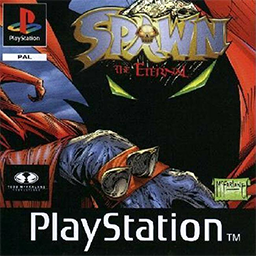
Spawn: The Eternal is an action-adventure video game developed by Sony Interactive Studios America and published by Sony Computer Entertainment for the PlayStation, based on the comic book character Spawn created by Todd McFarlane and produced by Image Comics. It was released on December 1, 1997 in North America and received poor reviews. When played on a CD player, the disc would be revealed to contain a lengthy audio interview with Spawn creator Todd McFarlane.
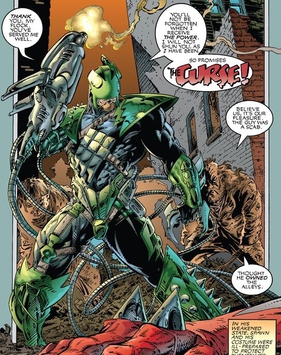
The Curse is a supervillain in the comic book Spawn. The Curse in the book is a billionaire and a religious zealot who seeks a place in Heaven and knows far more about the war between Heaven and Hell than most on Earth.

Spawn is an action-adventure video game developed and published by Konami for the Game Boy Color, based on the Spawn comic book character. The game was noted for its extensive use of digitized speech in cutscenes, a largely uncommon feature in games for the system.
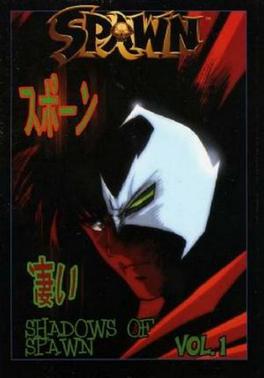
Shadows of Spawn is a licensed Japanese manga adaptation of Todd McFarlane's American Spawn comic series, written and drawn by Juzo Tokoro. It was originally printed in Japan from 1998 to 1999 in the monthly manga magazine Dengeki Comic Gao!, published by MediaWorks. The series retains a number of elements of the original American series, but also exhibits a number of differences from it as well.
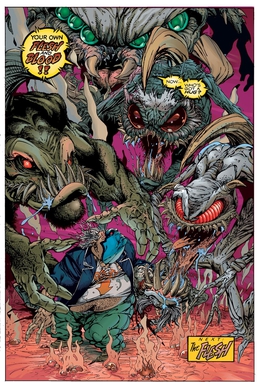
The Phlebiac Brothers are antagonists in Todd McFarlane's Spawn series of comic books.

















